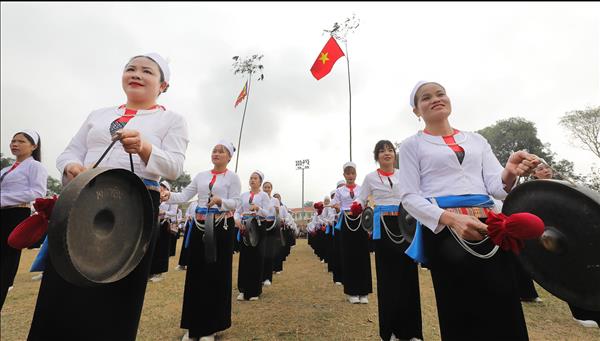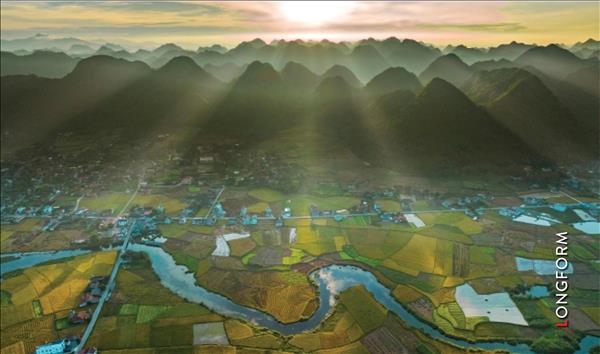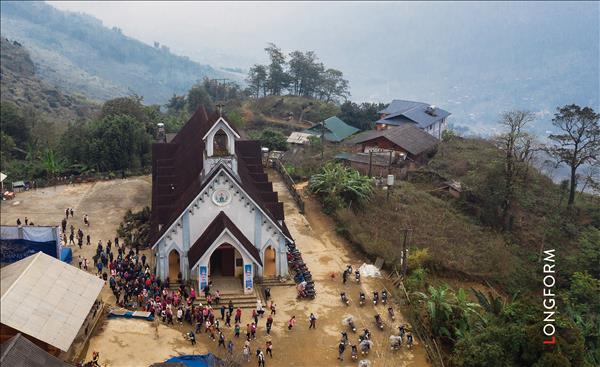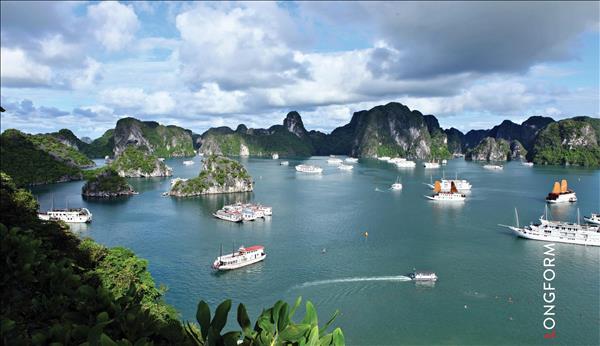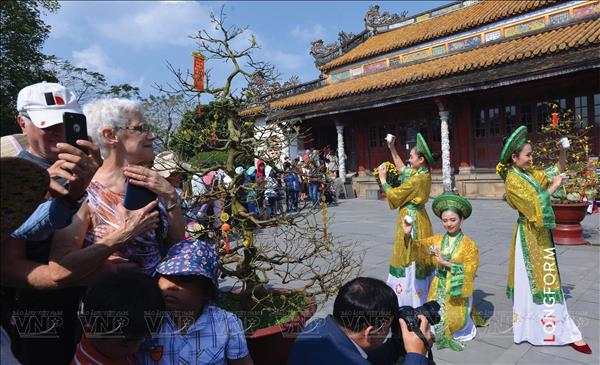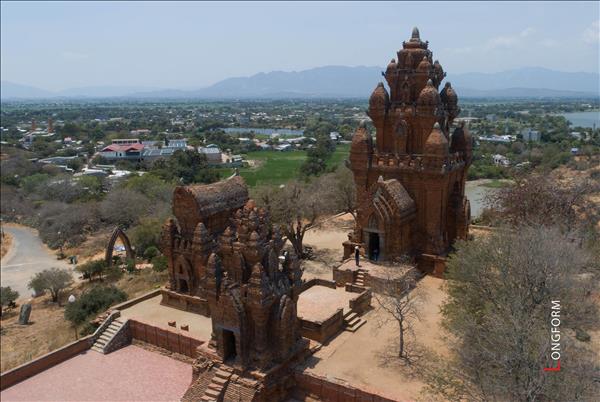To the land of “white rice and clear water”
Early in the morning, Yolanda Martinez and Marcelo Loper, two Spanish tourists, and their guide, left their hotel, boarding a native’s small boat to Cai Rang Floating Market known so far and wide in Western Cochinchine that everyone who comes to Can Tho also wishes to go there at least once.
Cai Rang floating market is a fruit and farm produce wholesale market of the Mekong River delta region. It is held on the Cai Rang River at a section near Cai Rang bridge, which is some 6km by land from Can Tho City and about 30 minutes by boat from Ninh Kieu wharf.
In the early morning, the market bustles with buyers and sellers, small boats fully loaded with fruits and agricultural products moving to and fro, with noises from boats, and the announcements of one’s wares and calls to each other.
The two Spanish visitors enthusiastically enjoy their breakfasts with “hu tieu” (vermicelli noodle soup with pork wrapped up in wheat flour) sold on a mobile boat. Perhaps, to them, it is truly a strange feeling on a floating market where buying and selling take place in a lively but simple manner on a river, rarely seen in their country and many other places in the world.
When the sun is high, Yolanda Martinez and Marcelo Loper continue their boat journey to Ut Hien homestay tourist site where they have their meals, a rest and other daily-life activities together with family members, and discover orchards full of tropical fruits as well as the peculiar cultural life of the Cochinchine countryside.
Yolanda Martinez confides: “The life and activities of people here are so ordinary and simple and very close to nature. In Spain we live in cities, so we earnestly desire to go to safe as well as clean and healthy places like this to rest, relax and discover things”.
Can Tho has its own tourist advantages with many noted places bearing cultural and historical identities of southern Vietnam, such as Ninh Kieu wharf, Binh Thuy ancient house and Cai Rang floating market. Based on its natural advantages of an area crisscrossed with rivers and canals, green orchards and countryside delicacies, Can Tho currently begins attaching importance to the development of various tourist forms, including green tourism and community tourism, with a view to creating new discovery tours for visitors.
At Tran Thi My Hien’s homestay tourist site in Ba Lang Ward, Cai Rang District, in only two hours, she received over 300 foreign tourists visiting her orchard. She tells us she has been developing this tourist model since 2006 with an orchard planted with different kinds of fruit trees of southern Vietnam, with rest areas and different food and drink locations. Coming here, visitors can experience the joy of cake making, cooking, fruit picking, overnight stays on bamboo beds and talking with family members about the life and culture of the southern land crisscrossed with rivers and canals.
Currently, there exist in Can Tho 14 homestay tourist locations like this, with investment largely by local inhabitants, which bring into full play the tourist advantage of river-crisscrossed land. Prominently is My Khanh tourist village of more than 15ha, with various attractive tourist forms such as folk singing, folk games, dog and pig racing, which draws a large number of visitors.
In addition to the development of various tourist models, Can Tho tourist service also focuses on the construction of an infrastructure and contingent of tourist professionals. Up to now, there are 236 tourist accommodation establishments in Can Tho with more than 6,000 rooms, including five-star hotels and high-class riverside rest and convalescence resorts.
Tran Viet Phuong, Director of Can Tho Municipal Culture, Sports and Tourism Department, revealed: Can Tho tries its best for tourist development towards sustainability, ensuring to preserve the distinctive cultural values and meeting the criteria of “safety, friendliness and quality”. Tourism will help people increase their income, raise their living standards, thus bringing about economic benefits for the locality.
The economic link of the entire region
As analysed by many economic experts, Can Tho is a centrally run city, on the one hand, and the gate of the entire Mekong River basin, on the other; an economic and cultural centre and an important intra-regional and international traffic hub of the Mekong River delta region and the whole country. It is endowed with many advantages to become a logistics and industrial centre, spurring the development of the entire Mekong River delta region.
Besides Can Tho international airport, investment has been made in vigorous development of the system of waterway ports. Can Tho Port Joint-Stock Company currently manages two ports, Cai Cui ( Tan Phu Ward, Cai Rang District) and Hoang Dieu (Binh Thuy District). Cai Cui port is constructed to become an international general port in service of transportation of container export and import goods of the Mekong River delta to key national ports, Cambodia and countries in the Mekong sub-region. This is considered the best regional port covering a total area of more than 39ha, with systems of modern dry-dock infrastructures, loading and unloading equipment, storehouses and storing yards, which can accommodate ships of 20,000tonnes. According to many experts, Cai Cui will be a central port for Can Tho’s logistics service.
In addition to these two ports, Can Tho also has Tra Noc, Tan Cang-Thot Not ports, which lie in the agricultural and aquatic product zones of Can Tho as well as An Giang, Dong Thap and Vinh Long provinces, which are convenient for traffic and commodity transportation.
Evaluating the development of the port system in Can Tho, Phan Thanh Tien, General Director of Can Tho Port Joint-Stock Company, said, “Once it becomes the logistics center of the Mekong River delta region, Can Tho will bring into play its role as a multi-media logistic service centre of the whole region. By then, transportation costs will be reduced for key commodities of the Mekong River delta region, which shall not be carried for loading in ports in Ho Chi Minh City or Vung Tau.
Another advantage of Can Tho is the system of eight industrial parks, including six operating ones and two under the planning process, which cover a total land area of 2,267ha, concentrating on the production of advantageous commodities such as aquatic products, rice, garments, farm machines and steel. This will serve as a basis for Can Tho to become an industrial city by 2020.
Along Highway 91, the industrial parks of Tra Noc 1 and Tra Noc 2 emerge on an area of 300ha with complete infrastructures, where more than 180 projects have operated stably for many years.
The 600ha-Thot Not industrial park is situated at a location adjacent to localities rich in agricultural and aquatic raw materials like rice and cat fish in An Giang, Dong Thap and Kien Giang. It is an ideal place for investment by enterprises, with numerous advantages and preferential policies, such as a large land fund, corporate income tax exemption for the initial years and quick procedures.
Nguyen Huu Phuoc, Deputy Head of Can Tho Export Processing Zone and Industrial Park Management Board, said: “ We continue creating more favourable conditions such as the shortest administrative procedures via one-stop mechanism in the grant and adjustment of investment registration certificates, grant of planning and construction certificates, grant of work permits for foreigners, grant of D Form commodity certificates, appraisal of base designs and approval of reports on environmental impacts”.
With the above-mentioned prominent potentials, Can Tho will soon become a socio-economic center, acting as the driving force for vigorous development of the entire Mekong River delta region as expected by the central government.
Early in the morning, Yolanda Martinez and Marcelo Loper, two Spanish tourists, and their guide, left their hotel, boarding a native’s small boat to Cai Rang Floating Market known so far and wide in Western Cochinchine that everyone who comes to Can Tho also wishes to go there at least once.
Cai Rang floating market is a fruit and farm produce wholesale market of the Mekong River delta region. It is held on the Cai Rang River at a section near Cai Rang bridge, which is some 6km by land from Can Tho City and about 30 minutes by boat from Ninh Kieu wharf.
In the early morning, the market bustles with buyers and sellers, small boats fully loaded with fruits and agricultural products moving to and fro, with noises from boats, and the announcements of one’s wares and calls to each other.
 Cai Rang floating market is a famous whole-sale market of agricultural produces and fruit in the region. Photo: Trong Chinh/VNP 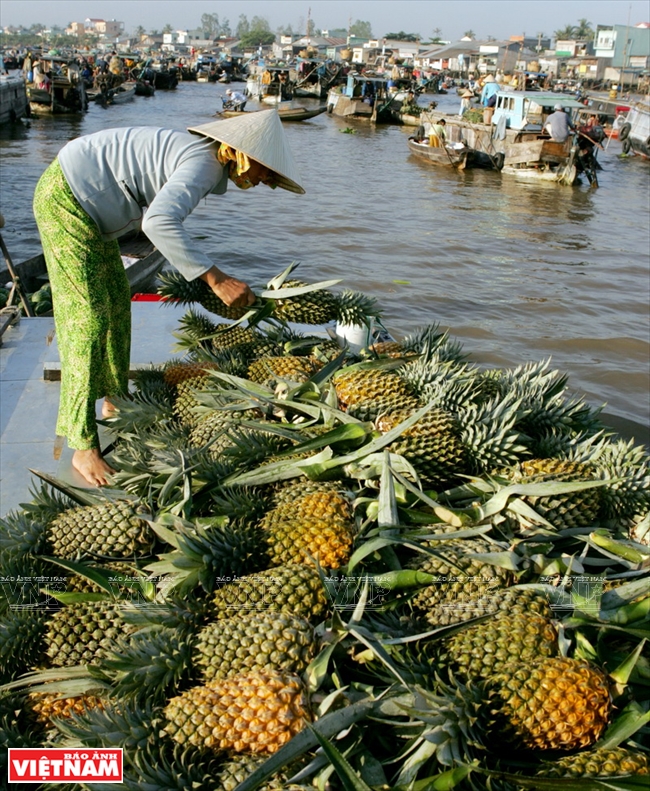 A boat is full of pineapple on the floating market. Photo: Trong Chinh/VNP  All trade activites take place on the river. Photo: VNP's file 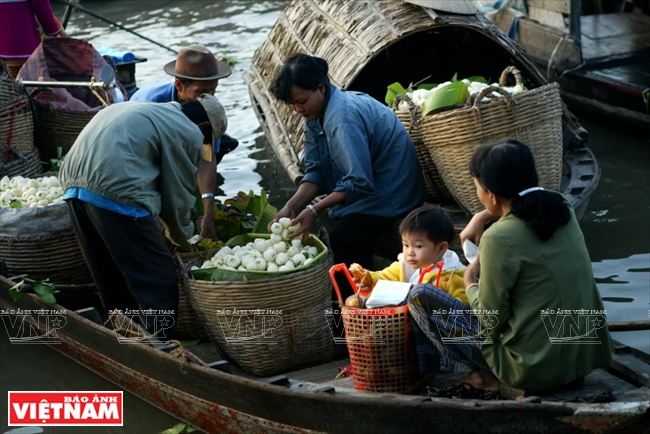 Many types of delicious fruit in the south are sold on Cai Rang floating market. Photo: VNP's file Foreign tourists visit the Cai Rang floating market. Photo: Nguyen Luan/VNP 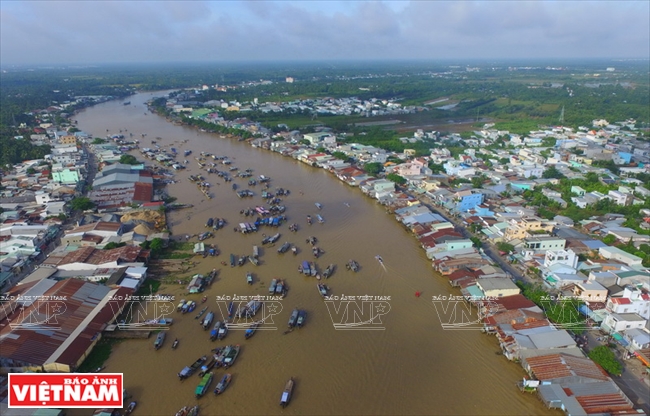 The Cai Rang floating market with boats loaded with agricultural products seen from above. Photo: Hoang Ha/VNP |
The two Spanish visitors enthusiastically enjoy their breakfasts with “hu tieu” (vermicelli noodle soup with pork wrapped up in wheat flour) sold on a mobile boat. Perhaps, to them, it is truly a strange feeling on a floating market where buying and selling take place in a lively but simple manner on a river, rarely seen in their country and many other places in the world.
| Can Tho has its own tourist advantages with many noted places bearing cultural and historical identities of southern Vietnam, such as Ninh Kieu wharf, Binh Thuy ancient house and Cai Rang floating market. |
Yolanda Martinez confides: “The life and activities of people here are so ordinary and simple and very close to nature. In Spain we live in cities, so we earnestly desire to go to safe as well as clean and healthy places like this to rest, relax and discover things”.
Can Tho has its own tourist advantages with many noted places bearing cultural and historical identities of southern Vietnam, such as Ninh Kieu wharf, Binh Thuy ancient house and Cai Rang floating market. Based on its natural advantages of an area crisscrossed with rivers and canals, green orchards and countryside delicacies, Can Tho currently begins attaching importance to the development of various tourist forms, including green tourism and community tourism, with a view to creating new discovery tours for visitors.
At Tran Thi My Hien’s homestay tourist site in Ba Lang Ward, Cai Rang District, in only two hours, she received over 300 foreign tourists visiting her orchard. She tells us she has been developing this tourist model since 2006 with an orchard planted with different kinds of fruit trees of southern Vietnam, with rest areas and different food and drink locations. Coming here, visitors can experience the joy of cake making, cooking, fruit picking, overnight stays on bamboo beds and talking with family members about the life and culture of the southern land crisscrossed with rivers and canals.
|
Foreign visitors enjoy tea and fruit at the Ut Hien homestay tourist site. Photo: Nguyen Luan/VNP Foreign tourists discover the southern countryside by bike. Photo: Nguyen Luan/VNP Foreign visitors cross a cau khi (a small bamboo bridge), a typical feature of the southern area. Photo: Nguyen Luan/VNP 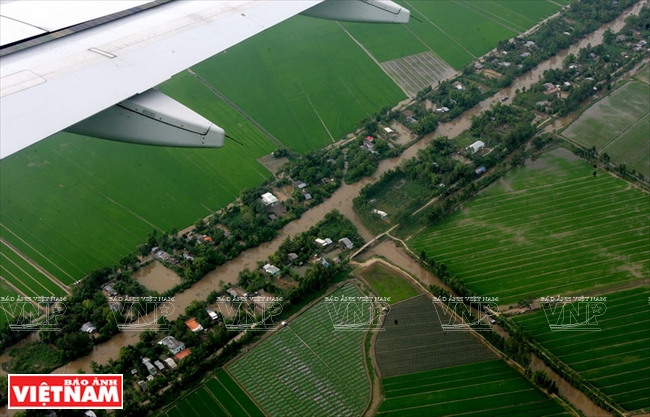 The system of crisscrossed rivers and canals and lush fruit orchards are favourable conditions for Can Tho to develop water tourism. Photo: TrongChinh/VNP  The ancient house of Binh Thuy in Binh Thuy District built in the French architectural style with five departments and two roofs in 1870 is a favourite destination for tourists visiting Can Tho. Photo: Trong Chinh/VNP Making Banh trang (rice paper) at a tourist area in Can Tho. Photo: Nguyen Luan/VNP A dog race course in My Khanh Tourist Village in Can Tho. Photo: Nguyen Luan/VNP Foreign tourists are curious about a species of animal in the southwestern region. Photo: Nguyen Luan/VNP Can Tho is well-known for many fruit delicacies. Photo: Nguyen Luan/VNP |
| Can Tho is considered the tourist centre of the Mekong River delta. By September 2016, over 1.3 million tourists, including nearly 200,000 foreign arrivals, had visited Can Tho. |
In addition to the development of various tourist models, Can Tho tourist service also focuses on the construction of an infrastructure and contingent of tourist professionals. Up to now, there are 236 tourist accommodation establishments in Can Tho with more than 6,000 rooms, including five-star hotels and high-class riverside rest and convalescence resorts.
Tran Viet Phuong, Director of Can Tho Municipal Culture, Sports and Tourism Department, revealed: Can Tho tries its best for tourist development towards sustainability, ensuring to preserve the distinctive cultural values and meeting the criteria of “safety, friendliness and quality”. Tourism will help people increase their income, raise their living standards, thus bringing about economic benefits for the locality.
The economic link of the entire region
As analysed by many economic experts, Can Tho is a centrally run city, on the one hand, and the gate of the entire Mekong River basin, on the other; an economic and cultural centre and an important intra-regional and international traffic hub of the Mekong River delta region and the whole country. It is endowed with many advantages to become a logistics and industrial centre, spurring the development of the entire Mekong River delta region.
Besides Can Tho international airport, investment has been made in vigorous development of the system of waterway ports. Can Tho Port Joint-Stock Company currently manages two ports, Cai Cui ( Tan Phu Ward, Cai Rang District) and Hoang Dieu (Binh Thuy District). Cai Cui port is constructed to become an international general port in service of transportation of container export and import goods of the Mekong River delta to key national ports, Cambodia and countries in the Mekong sub-region. This is considered the best regional port covering a total area of more than 39ha, with systems of modern dry-dock infrastructures, loading and unloading equipment, storehouses and storing yards, which can accommodate ships of 20,000tonnes. According to many experts, Cai Cui will be a central port for Can Tho’s logistics service.
In addition to these two ports, Can Tho also has Tra Noc, Tan Cang-Thot Not ports, which lie in the agricultural and aquatic product zones of Can Tho as well as An Giang, Dong Thap and Vinh Long provinces, which are convenient for traffic and commodity transportation.
|
Seafood is one of the key export products in Can Tho. Photo: Nguyen Luan/VNP Loading rice on the Hau River. Photo: Nguyen Luan/VNP Can Tho has the strength in producing and trading agricultural machines. Photo: Nguyen Luan/VNP |
Evaluating the development of the port system in Can Tho, Phan Thanh Tien, General Director of Can Tho Port Joint-Stock Company, said, “Once it becomes the logistics center of the Mekong River delta region, Can Tho will bring into play its role as a multi-media logistic service centre of the whole region. By then, transportation costs will be reduced for key commodities of the Mekong River delta region, which shall not be carried for loading in ports in Ho Chi Minh City or Vung Tau.
|
“It is expected that by 2020 the volume of commodities transported via Can Tho approximates 47 to 62 million tonnes. When the Ho Chi Minh City - Can Tho railroad is completed, Can Tho will be the most favorable place in the Mekong River delta region for construction of a regional logistic centre.
((Nguyen Trong Cuong, director of Can Tho Socio-Economic Institute))
|
Along Highway 91, the industrial parks of Tra Noc 1 and Tra Noc 2 emerge on an area of 300ha with complete infrastructures, where more than 180 projects have operated stably for many years.
The 600ha-Thot Not industrial park is situated at a location adjacent to localities rich in agricultural and aquatic raw materials like rice and cat fish in An Giang, Dong Thap and Kien Giang. It is an ideal place for investment by enterprises, with numerous advantages and preferential policies, such as a large land fund, corporate income tax exemption for the initial years and quick procedures.
Nguyen Huu Phuoc, Deputy Head of Can Tho Export Processing Zone and Industrial Park Management Board, said: “ We continue creating more favourable conditions such as the shortest administrative procedures via one-stop mechanism in the grant and adjustment of investment registration certificates, grant of planning and construction certificates, grant of work permits for foreigners, grant of D Form commodity certificates, appraisal of base designs and approval of reports on environmental impacts”.
With the above-mentioned prominent potentials, Can Tho will soon become a socio-economic center, acting as the driving force for vigorous development of the entire Mekong River delta region as expected by the central government.
Story: Nguyen Oanh - Photos: Nguyen Luan, Trong Chinh, Hoang Ha & VNP’s files

